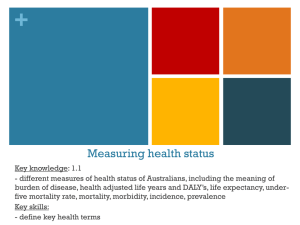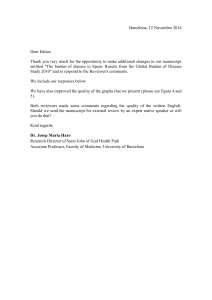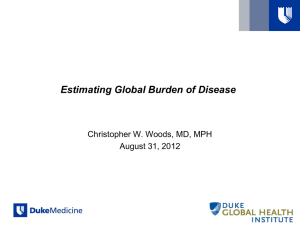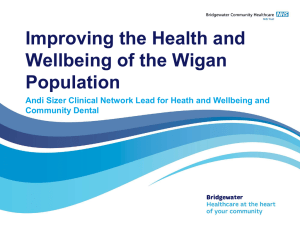Measuring Global Burden of Disease
advertisement
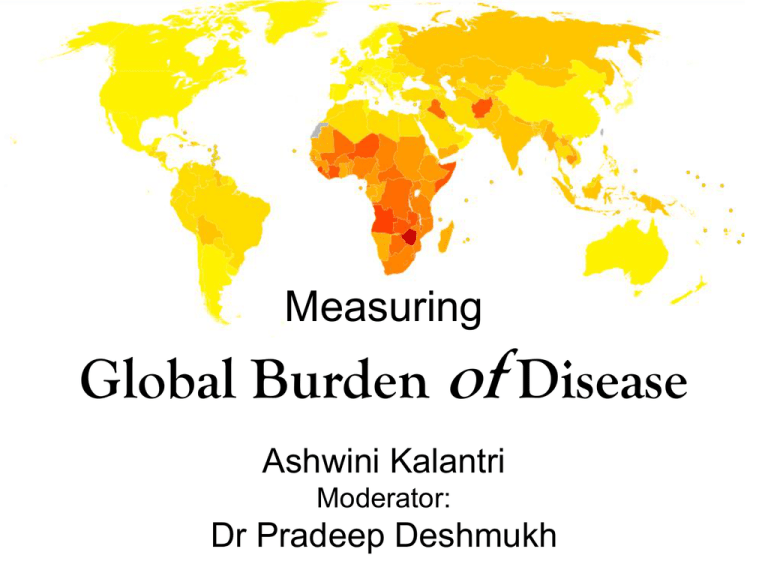
Measuring Global Burden of Disease Ashwini Kalantri Moderator: Dr Pradeep Deshmukh Global Burden of Disease • Rationale (Why?) – Assess health status over time – Input to health decision-making and planning processes Global Burden of Disease – How? • • • • Morbidity indicators Mortality indicators Disability indicators Nutritional status indicators • Health Care delivery indicators • Utilization Rates • Indicators of Social and Mental Health • Environmental Indicators • Socio-economic Indicators • Health Policy Indicators • Indicators of quality of Life Global Burden of Disease • Summary measures of population health: measures that combine information on mortality and non-fatal health outcomes to represent the health of a particular population as a single number History • 1940s: Concept of “Years of Life Lost”. • 1971: Sullivan’s Index • 1983: Quality Adjusted Life Expectancy (QALE). • 1990: GBD study – DALYs. • 1998: HeaLY • DALE, HALE, QALY, DFLE followed SMPH - Types Health Expectancy Health expectancies measure years of life gained or years of improved quality of life. – Disability-free life expectancy (DFLE) – Disability-adjusted life expectancy (DALE) – Healthy adjusted life expectancy (HALE) – Quality adjusted life expectancy (QALE) Health Gaps Health gaps measure lost years of full health in comparison with some ‘ideal’ health status or accepted standard. – Potential Years of Life Lost (PYLL) – Quality Adjusted Life Years (QALY), – Disability Adjusted Life Years (DALY) Survival Curve 100 C 90 80 B % Surviving 70 Time lived in suboptimal health 60 Time lost due to mortality 50 40 A 30 Time lived in optimal health 20 10 0 0 5 10 15 20 25 30 35 40 45 50 55 60 65 70 75 80 85 90 100 Age Life Expectancy • Total life expectancy at birth is given by the area under the upper curve • Total life expectancy at birth = A + B 100 C 80 • A = time lived in optimal health • B = time lived in suboptimal health 60 40 20 0 B A Health Expectancy • Health expectancies are population indicators that estimate the average time that a person could expect to live in a defined state of health • Health Expectancy = A + f (B) 100 • A = time lived in optimal health • B = time lived in suboptimal health • f (B) = function that assigns weights to years lived in suboptimal health (optimal health has a weight of 1) C 80 60 40 20 0 B A Health Gaps • Health gaps measure the difference between actual population health and some specified standard or goal • Health Gap = C + f (B) 100 • B = time lived in suboptimal health • C = time lost due to mortality • f (B) = function that assigns weights to health states lived during time B, but where a weight of 1 equals to time lived in a health state equivalent to death C 80 60 40 20 0 B A DALE Disability Adjusted Life Expectancy • DALE integrates data on – Mortality – Long – term institutionalization – Activity limitations • Measures Quality and Quantity of life • A set of weights is assigned to four states of health – – – – no activity limitations activity limitations in leisure activities or transportation activity limitations at work, home and/or school institutionalization in a health care facility HALE Health Adjusted Life Expectancy • Health-adjusted life expectancy is the number of years in full health that an individual can expect to live given the current morbidity and mortality conditions. • Health-adjusted life expectancy uses the Health Utility Index (HUI) to weigh years lived in good health higher than years lived in poor health. • Measure of quantity and quality of life QALY Quality Adjusted Life Years • Measures both quality and quantity • Used for cost-benefit analysis • Number of years added due to the intervention DALY Disability Adjusted Life Years DALY is a measure of overall disease burden, expressed as the cumulative number of years lost due to ill-health, disability or early death DALY Objectives • Inclusion of non-fatal health outcomes in the debate on international health policy • To quantify the burden of disease using a measure that could also be used for costeffectiveness analysis. DALY Disability Weights • The ‘valuation’ of time lived in non-fatal health states • Weights are measured as a number on a scale of 0 to 1, where 0 is assigned to a state comparable to death and 1 is assigned to a state of optimal health • Because the DALY measures loss of health, the weights are inverted for DALY calculation with 0 representing a state of optimal health (no loss) and 1 representing a state equivalent to death. DALY Disability Weights • Weight for paraplegia of 0.57 - does not mean – Half dead – Halfway between life and death – Society values them as a person less than anyone else. • A year with blindness (weight 0.43) > a year with paraplegia (weight 0.57) > a year with unremitting unipolar major depression (weight 0.76). • A year in good health followed by death > a year with paraplegia followed by death. • A person to live three years with paraplegia followed by death > one year of good health followed by death – (3 years x (1-0.57) = 1.3 ‘healthy’ years is greater than 1 year of good health). DALY Disability Weights Disease Disability Weights Tuberculosis 0.331 (0.222– 0.450) HIV/AIDS 0.547 (0.382–0.715) Major Depression 0.655 (0.469–0.816) Moderate Generalized Musculoskeletal Problems Iodine-deficiency goitre 0.292 (0.197–0.410) Kwashiorkor 0.055 (0.033–0.085) Severe wasting 0.127 (0.081–0.183) 0.200 (0.134–0.283) DALY Discounting • The GBD applied a 3% time discount rate to years of life lost in the future to estimate the net present value of years of life lost. • With this discount rate, a year of healthy life gained in 10 years’ time is worth 24% less than one gained now. DALY Discounting – Why? • To be consistent with measurement of health outcomes in cost-effectiveness analyses • To prevent giving excessive weight to deaths at younger ages • Disease eradication/research paradox DALY Calculations DALY = Years Lived with Disability (YLD) + Years of Life Lost (YLL) YLD Years Lived with Disability • YLD = I x DW x L • I = number of incident cases • DW = disability weight • L = average duration of the case until remission or death (years) YLL Years of Life Lost • YLL = N x L • N = number of deaths • L = standard life expectancy at age of death in yrs DALY Critique • Doesn’t help determine the right intervention • The true “burden” of disease will depend on the economic, family and social circumstances • Multi-pathology is not the same as multicausality. DALY Critique • Discriminates against young and the old • Does not assess qualitative difference in outcomes • No Male-Female difference in length of life • Discounting future health outcomes The Global Burden of Disease Study 2010 DALYs / 1,00,000 GBD Study 2010 Cause 1990 2010 Change Tuberculosis 1155 717 -37.9% HIV/AIDS 342 1184 246.3% Malaria 1304 1200 -8.0% Common Infectious Diseases 10245 4107 -59.9% Maternal Disorder 407 234 -42.6% Mental disorders 2539 2688 5.9% Endocrine Disorders 1605 1777 10.7% Musculoskeletal Disorders 2198 2462 12% All Causes 47205 36145 -23.4% Global DALY Trends India - DALY Trends References 1. 2. 3. 4. Donev D, Zaletel-Kragelj L, Bjegović V, Burazeri G. Measuring the burden of disease: Disability Adjusted Life Years (DALY). Methods and tools in public health. 2010;30:715. Murray CJL, Lopez AD. Global comparative assessments in the health sector: disease burden, expenditures and intervention packages : collected reprints from the Bulletin of the World Health Organization: World Health Organization; 1994. Mathers CD, Vos T, Lopez AD, Salomon J, Ezzati M (ed.) 2001. National Burden of Disease Studies: A Practical Guide. Edition 2.0. Global Program on Evidence for Health Policy. Geneva: World Health Organization. Murray CJL, Vos T, Lozano R, Naghavi M, Flaxman AD, Michaud C, et al. Disability-adjusted life years (DALYs) for 291 diseases and injuries in 21 regions, 1990?2010: a systematic analysis for the Global Burden of Disease Study 2010. The Lancet. 2012;380(9859):2197-223. References 5. 6. 7. 8. 9. Mathers CD, Fat DM, Boerma JT, Organization WH. The Global Burden of Disease: 2004 Update: World Health Organization; 2008. Murray CJL. Summary measures of population health, 2002: concepts, ethics, measurement and applications: World Health Organization; 2002. Global Burden of Disease. Institute of Health Metrics and Evaluation; 2012 [cited 2013 24 July]; Available from: http://www.healthmetricsandevaluation.org/gbd. Sayers B, Fliedner T. The critique of DALYs: a counter-reply. Bulletin of the World Health Organization. 1997;75(4):383. Salomon JA, Vos T, Hogan DR, Gagnon M, Naghavi M, Mokdad A, et al. Common values in assessing health outcomes from disease and injury: disability weights measurement study for the Global Burden of Disease Study 2010. The Lancet. 2013;380(9859):2129-43.


